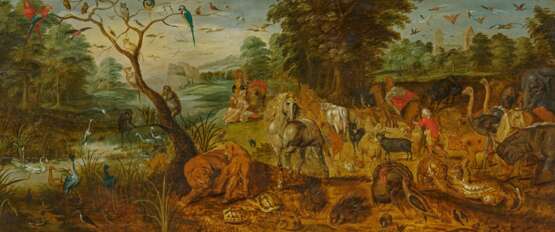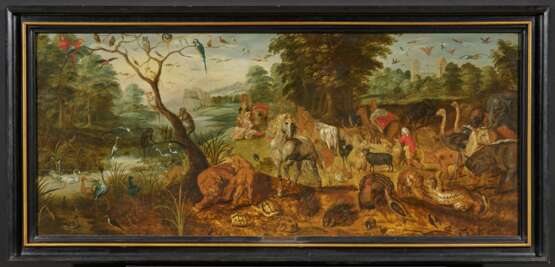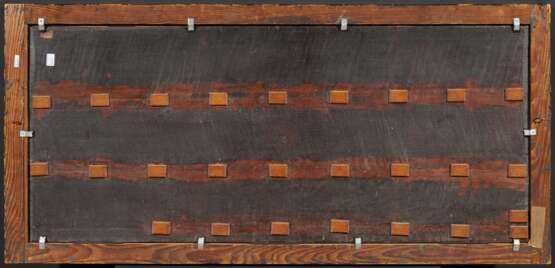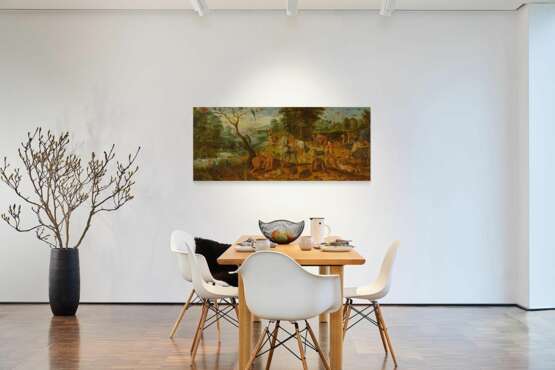ID 1072393
Лот 1222 | Jan d.J. Brueghel. Paradise Landscape with the Animals Entering Noah's Ark
Оценочная стоимость
€ 150 000 – 300 000
Antwerp 1601 - 1678
Title: Paradise Landscape with the Animals Entering Noah's Ark.
Technique: Oil on wood.
Measurement: 70 x 170cm.
Frame: Framed.
Verso:
On the panel, hallmark of the Antwerp Guild of St. Luke with hands and tower.
Certificate:
Klaus Ertz, Lingen 20 January 2022.
Provenance:
Lempertz auction 1896/98, according to the consignor; since then private property, Germany.
Cf. literature:
Klaus Ertz, Jan Brueghel d.J., Die Gemälde mit kritischem Ouvrekatalog, Freren 1984;
Klaus Ertz, Christa Nitze-Ertz, Jan Brueghel d.Ä., Die Gemälde mit kritischem Ouvrekatalog, Volume I-IV, Lingen 2008-10.
Jan Brueghel the Elder (1568 - 1625) conceived this wonderful scenery.
The son of Pieter Bruegel the Elder was one of the most famous artists in the Spanish Netherlands around 1700, admired and praised especially for his exquisite depictions of flora and fauna. The diversity of God's creation, which the princes of his time collected in chambers of art and curiosities, he presented in brilliant paintings. With the procession of the animals to Noah's Ark, still lying on dry land in the background of the painting, he found an Old Testament theme with which he could vary his popular depictions of the Garden of Eden. His paintings were in great demand at all the courts of Europe. A painting by the artist later also called "Paradise Brueghel" was a "must-have" for every collector.
When Jan Brueghel the Elder died suddenly of cholera in 1625, his eldest son, Jan the Younger, was 24 years old and was in Italy for further training, having probably already worked in his father's workshop for more than a decade. Suddenly, "the junior" was given responsibility for a headstrong family and for a flourishing workshop in Antwerp. Back in his homeland, he proved equal to these challenges. Jan the Younger was quickly accepted as a member of the St. Luke's Guild, of which he was to become dean in the early 1630s.
In addition to works he created himself and the collaboration with other painters that was so common at the time (Hendrik van Balen, Peter Paul Rubens or Joos de Momper the Younger, among others), the paintings left unfinished by his father as well as the demand for paintings in his father's style formed a foundation for his economic success.
Today we know of four paintings by the Father that focus on the entry of the animals into the ark. Three of them, dated by the leading Brueghel scholar Klaus Ertz between 1613 and 1615, are very close to our painting in composition. Jan Brueghel the Younger reproduced this design at least four times. Klaus Ertz lists three of the works in the catalogue raisonné of Jan Brueghel the Younger and dates them to the 1630s.
Klaus Ertz was able to examine this painting in the original. He came to the conclusion that it is the latest in the genesis of this "family of pictures" and was probably created in the 1650s. In one respect, our painting differs from the works discussed so far: The picture panel has a more transverse-rectangular format. Perhaps this change was made at the request of the commissioner, as Klaus Ertz assumes in his expert opinion.
This change in format, with the composition remaining unchanged, reinforces the tendency that can be observed in the comparison of the works by father and son: The pictorial elements are more loosely grouped by Jan Brueghel the Younger than by his father, they take up more of their own space and thus also acquire a somewhat greater lightness. In this particular case, this impression is also reinforced by the very light, partly glazed style of painting.
The entire Habsburg family, not least the emperors Maximilian II and Rudolf II in Prague, were intensely interested in animals and maintained prestigious menageries as early as the early 16th century. As an official court painter, Jan Brueghel the Elder had access to the Brussels menageries, where the governors of the Netherlands (collected) living specimens of the exotic animals of the Habsburg domain. Here the painter could study them intensively and make sketches.
The most diverse animals of all continents are to be marvelled at in this broad panorama. They linger on the picture-parallel stage of the foreground, then move diagonally from the right edge of the picture to the centre back. Noah himself and two women, loaded with provisions, wait in the middle ground for the animals and a boy who drives the camels, also loaded with luggage. In the background lies the ark as a saving refuge.
There is no real order yet; mostly two individuals of one species can be seen, but some have not yet found their partner or are standing away from him in the turmoil. The right edge of the picture overlaps a single elephant, but outside the frame more animals will follow, certainly also its partner.
Only the grey stallion in the centre - clearly Spanish - is alone. He has a special role in the painting. Like a representative of Spanish rule, he seems to be directing the procession of his "subjects" from all over the world. The lion is not the king here, his interest is exclusively in his partner.
The group of lions and the group of leopards, as well as this striking grey stallion, are motifs that Jan Brueghel the Elder adopted from his close friend and congenial partner in many joint paintings, Peter Paul Rubens. The adoption of these motifs is by no means due to a lack of creativity of his own. Rather, it is a reverence to the great colleague and friend and offered the knowledgeable viewer the pleasure of recognition.
This painting can also be understood in this way, as a son's reverence for his father, as a last re-recording of a composition that continues to enchant viewers to this day.
| Автор: | Ян Брейгель II (1601 - 1678) |
|---|---|
| Техника исполнения: | Масло |
| Категория аукционного дома: | Старые мастера |
| Автор: | Ян Брейгель II (1601 - 1678) |
|---|---|
| Техника исполнения: | Масло |
| Категория аукционного дома: | Старые мастера |
| Адрес торгов |
VAN HAM Kunstauktionen GmbH Hitzelerstr. 2 50968 Köln Германия | ||||||||||||||
|---|---|---|---|---|---|---|---|---|---|---|---|---|---|---|---|
| Предосмотр |
| ||||||||||||||
| Телефон | +49 221 92586215 | ||||||||||||||
| Факс | +49 221 92 58 62 4 | ||||||||||||||
| Комиссия | 32% | ||||||||||||||
| Условия использования | Условия использования | ||||||||||||||
| Часы работы | Часы работы
|














